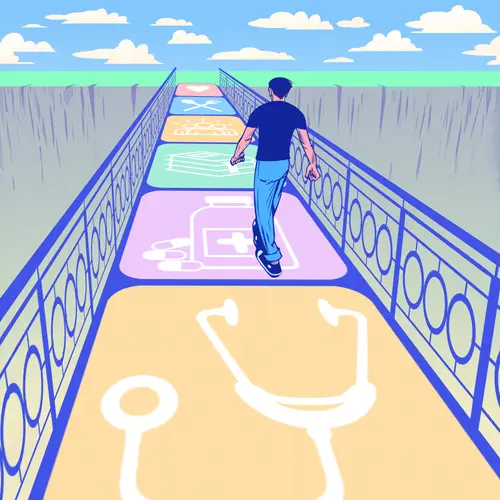Appendix testis torsion is a condition that affects the testes of the male reproductive system. This article looks at the symptoms and causes of this condition and how it can be diagnosed and treated.
What Is the Appendix Testis Torsion?
The appendix testis is a tiny piece of tissue attached to the upper part of the testes (testicle). It’s present in roughly 76% to 83% of male children at birth. It’s a useless piece of tissue in the testicles left over from growth as an embryo.
This tissue is a remnant of the Müllerian duct. As this duct (which otherwise grows into the female reproductive system) does not have any function in boys, it simply becomes excess tissue. This is similar to the appendix in the abdomen, which has no known function. The appendix testis is also called the testicular appendix or hydatid of Morgagni.
The tissue that causes appendix testis torsion is tiny and does not usually produce many complications, but its twisting can be immensely painful. Torsion of the appendix testis is one of the most common causes of sharp scrotal pain in children before puberty.
Additionally, in some cases, the appendix testis twists so that it blocks the blood supply, which could lead to other complications.
Torsion of the Appendix Testis Symptoms
According to research, over 50% of boys who report severe scrotal pain are diagnosed with testicular appendage torsion. A study involving 238 boys under 19, all of whom reported acute scrotal pain, found that 46% of the boys were eventually diagnosed with torsion of the appendix testis, and 16% were diagnosed with testicular torsion.
Some of the symptoms of these conditions include:
- Swelling in the scrotum
- Scrotal pain (usually caused by the twisting of the appendix testis, which cuts off its blood supply)
- A blue dot on the scrotum caused by blood loss
Torsion of the Appendix Testis Causes
While the appendix testis is attached to the testicle, which increases its chances of torsion (getting twisted), the exact cause of most torsion has yet to be identified. Some research suggests that it could be due to trauma or enlargement of the testes as a male child approaches puberty, though. This would also explain the increased incidences of this condition between the ages of seven to 12 years.
That said, this condition can occur at any age. Some medical experts believe that seasonal causes such as decreased temperatures during the winter lead to higher rates, though.
Appendix Testis Torsion Diagnosis
A pediatrician will carry out a physical examination of your child to identify symptoms of appendix testis torsion and may also ask for your family history.
The physical examination may reveal tender tissue on the upper part of the testis, and there may be a tissue mass in the most delicate region. A physical examination may also rule out other serious conditions such as testicular torsion, a condition in which the testis rotates and reduces blood flow to the scrotum. If the condition has advanced sufficiently, though, the progressing inflammation may reduce the effectiveness of the physical examination.
In such a scenario, the doctor may suggest additional tests such as an x-ray or an ultrasound. In some cases, when test results remain inconclusive, a doctor may perform exploratory surgery to identify the condition.
How Long Does Torsion of Appendix Testis Last?
Torsion of the appendix testis usually doesn’t require substantial treatment and will clear up without much medical intervention. Doctors typically recommend managing the pain by resting to aid the healing process. Other methods that can help reduce the pain due to this condition include:
- Treating the affected area with ice
- Applying non-steroidal anti-inflammatory drugs
- Keeping the testes at an elevated position in relation to the rest of the body
- Using analgesics like acetaminophen and ibuprofen
The swelling and pain usually subside in a week. Your doctor may recommend surgery if the pain does not disappear even after a long time, though, or after other modes of treatment fail to offer relief.
Can an Appendix Testis Be Removed?
Yes. The appendix testis can be removed surgically, but doctors rarely recommend surgery even when the appendix testis is twisted. Still, in some cases where surgery is carried out in the same region to treat another condition, the surgeon may decide to remove the appendix testis to prevent a recurrence.
Is Appendix Testis the Same as Epididymal Appendix?
No. The epididymal appendix is different from the appendix testis. While both are tissue appendages in the testis, the epididymal appendix is a fragment of a different duct (called the Wolffian duct) left behind due to its incomplete growth.
What Is Testicular Torsion?
While appendix testis torsion is a condition that causes an extra appendage to twist, a testicular torsion directly affects one of the testicles. The spermatic cord – responsible for blood flow to the testicle – twists, cutting off circulation. This serious medical emergency can cause acute pain and swelling and requires instant attention.
Points to Remember About Appendix Testis Torsion
- The appendix testis is found in many children designated male at birth, and it can also sometimes lead to sharp pain.
- An appendix testis is very small, typically seven to 11 millimeters long.
- The appendix testis looks like a small blob of tissue. You cannot see it because it’s located on the testis under your skin.
- A normal appendix testis is like any other tissue and not abnormally hard. However, when it twists, it can sometimes form a hard lump that causes pain.
- If you or your child feels pain in the scrotum, go to the doctor to identify the cause of the pain.
- Most people will only notice the appendix testis after it’s twisted and causes pain.

